Nadav Bhonker
FPGAN-Control: A Controllable Fingerprint Generator for Training with Synthetic Data
Oct 29, 2023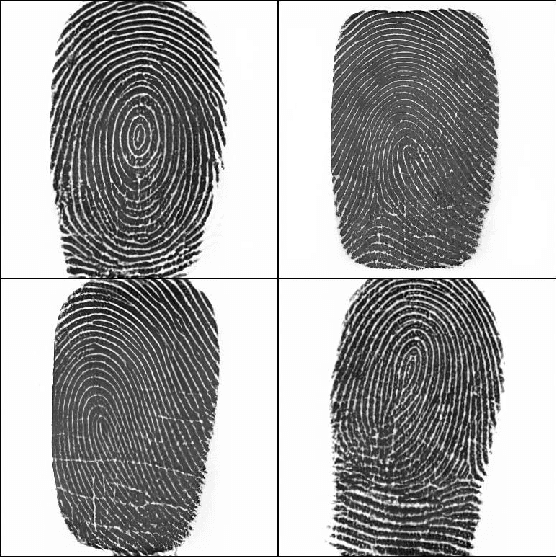


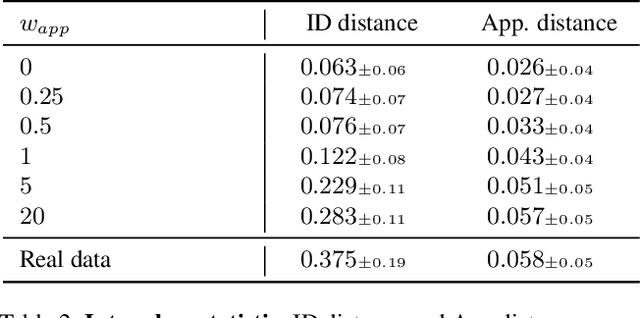
Abstract:Training fingerprint recognition models using synthetic data has recently gained increased attention in the biometric community as it alleviates the dependency on sensitive personal data. Existing approaches for fingerprint generation are limited in their ability to generate diverse impressions of the same finger, a key property for providing effective data for training recognition models. To address this gap, we present FPGAN-Control, an identity preserving image generation framework which enables control over the fingerprint's image appearance (e.g., fingerprint type, acquisition device, pressure level) of generated fingerprints. We introduce a novel appearance loss that encourages disentanglement between the fingerprint's identity and appearance properties. In our experiments, we used the publicly available NIST SD302 (N2N) dataset for training the FPGAN-Control model. We demonstrate the merits of FPGAN-Control, both quantitatively and qualitatively, in terms of identity preservation level, degree of appearance control, and low synthetic-to-real domain gap. Finally, training recognition models using only synthetic datasets generated by FPGAN-Control lead to recognition accuracies that are on par or even surpass models trained using real data. To the best of our knowledge, this is the first work to demonstrate this.
Asymmetric Face Recognition with Cross Model Compatible Ensembles
Mar 30, 2023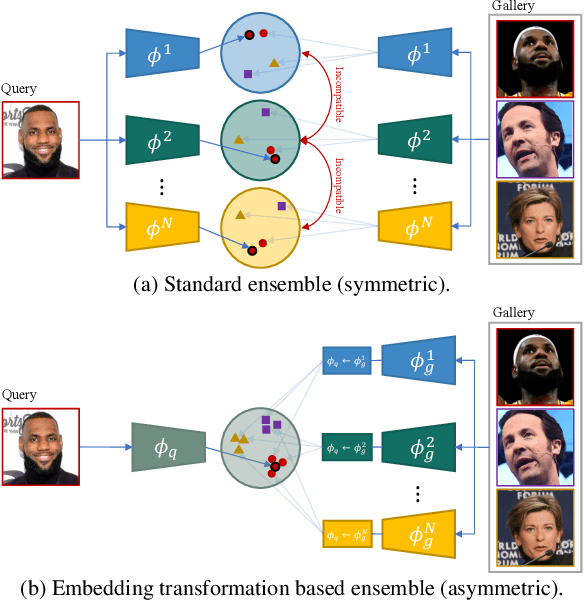
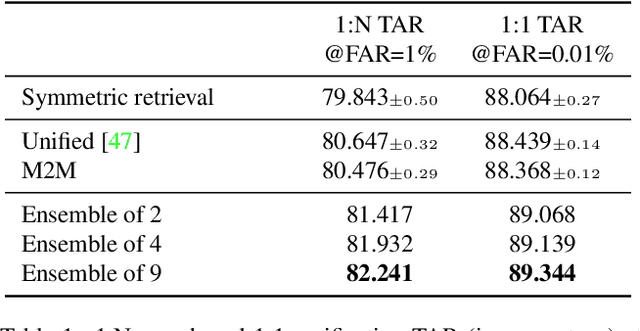
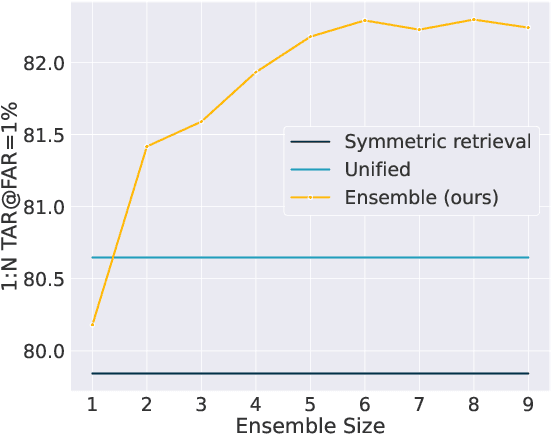
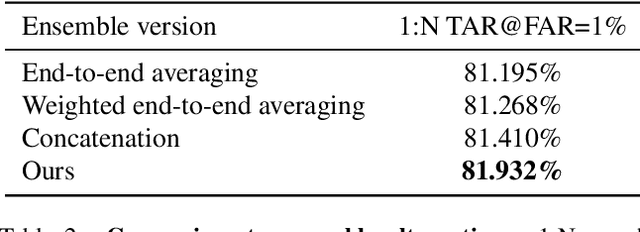
Abstract:The asymmetrical retrieval setting is a well suited solution for resource constrained face recognition. In this setting a large model is used for indexing the gallery while a lightweight model is used for querying. The key principle in such systems is ensuring that both models share the same embedding space. Most methods in this domain are based on knowledge distillation. While useful, they suffer from several drawbacks: they are upper-bounded by the performance of the single best model found and cannot be extended to use an ensemble of models in a straightforward manner. In this paper we present an approach that does not rely on knowledge distillation, rather it utilizes embedding transformation models. This allows the use of N independently trained and diverse gallery models (e.g., trained on different datasets or having a different architecture) and a single query model. As a result, we improve the overall accuracy beyond that of any single model while maintaining a low computational budget for querying. Additionally, we propose a gallery image rejection method that utilizes the diversity between multiple transformed embeddings to estimate the uncertainty of gallery images.
Synthetic Data for Model Selection
May 03, 2021



Abstract:Recent improvements in synthetic data generation make it possible to produce images that are highly photorealistic and indistinguishable from real ones. Furthermore, synthetic generation pipelines have the potential to generate an unlimited number of images. The combination of high photorealism and scale turn the synthetic data into a promising candidate for potentially improving various machine learning (ML) pipelines. Thus far, a large body of research in this field has focused on using synthetic images for training, by augmenting and enlarging training data. In contrast to using synthetic data for training, in this work we explore whether synthetic data can be beneficial for model selection. Considering the task of image classification, we demonstrate that when data is scarce, synthetic data can be used to replace the held out validation set, thus allowing to train on a larger dataset.
GAN-Control: Explicitly Controllable GANs
Jan 07, 2021


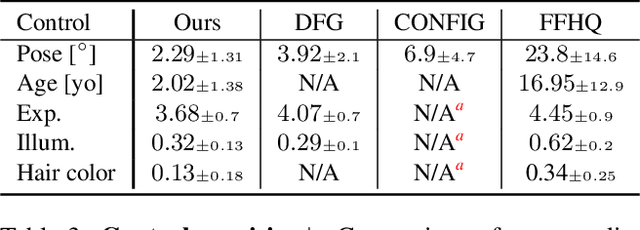
Abstract:We present a framework for training GANs with explicit control over generated images. We are able to control the generated image by settings exact attributes such as age, pose, expression, etc. Most approaches for editing GAN-generated images achieve partial control by leveraging the latent space disentanglement properties, obtained implicitly after standard GAN training. Such methods are able to change the relative intensity of certain attributes, but not explicitly set their values. Recently proposed methods, designed for explicit control over human faces, harness morphable 3D face models to allow fine-grained control capabilities in GANs. Unlike these methods, our control is not constrained to morphable 3D face model parameters and is extendable beyond the domain of human faces. Using contrastive learning, we obtain GANs with an explicitly disentangled latent space. This disentanglement is utilized to train control-encoders mapping human-interpretable inputs to suitable latent vectors, thus allowing explicit control. In the domain of human faces we demonstrate control over identity, age, pose, expression, hair color and illumination. We also demonstrate control capabilities of our framework in the domains of painted portraits and dog image generation. We demonstrate that our approach achieves state-of-the-art performance both qualitatively and quantitatively.
From Real to Synthetic and Back: Synthesizing Training Data for Multi-Person Scene Understanding
Jun 03, 2020



Abstract:We present a method for synthesizing naturally looking images of multiple people interacting in a specific scenario. These images benefit from the advantages of synthetic data: being fully controllable and fully annotated with any type of standard or custom-defined ground truth. To reduce the synthetic-to-real domain gap, we introduce a pipeline consisting of the following steps: 1) we render scenes in a context modeled after the real world, 2) we train a human parsing model on the synthetic images, 3) we use the model to estimate segmentation maps for real images, 4) we train a conditional generative adversarial network (cGAN) to learn the inverse mapping -- from a segmentation map to a real image, and 5) given new synthetic segmentation maps, we use the cGAN to generate realistic images. An illustration of our pipeline is presented in Figure 2. We use the generated data to train a multi-task model on the challenging tasks of UV mapping and dense depth estimation. We demonstrate the value of the data generation and the trained model, both quantitatively and qualitatively on the CMU Panoptic Dataset.
Playing SNES in the Retro Learning Environment
Feb 07, 2017



Abstract:Mastering a video game requires skill, tactics and strategy. While these attributes may be acquired naturally by human players, teaching them to a computer program is a far more challenging task. In recent years, extensive research was carried out in the field of reinforcement learning and numerous algorithms were introduced, aiming to learn how to perform human tasks such as playing video games. As a result, the Arcade Learning Environment (ALE) (Bellemare et al., 2013) has become a commonly used benchmark environment allowing algorithms to train on various Atari 2600 games. In many games the state-of-the-art algorithms outperform humans. In this paper we introduce a new learning environment, the Retro Learning Environment --- RLE, that can run games on the Super Nintendo Entertainment System (SNES), Sega Genesis and several other gaming consoles. The environment is expandable, allowing for more video games and consoles to be easily added to the environment, while maintaining the same interface as ALE. Moreover, RLE is compatible with Python and Torch. SNES games pose a significant challenge to current algorithms due to their higher level of complexity and versatility.
 Add to Chrome
Add to Chrome Add to Firefox
Add to Firefox Add to Edge
Add to Edge